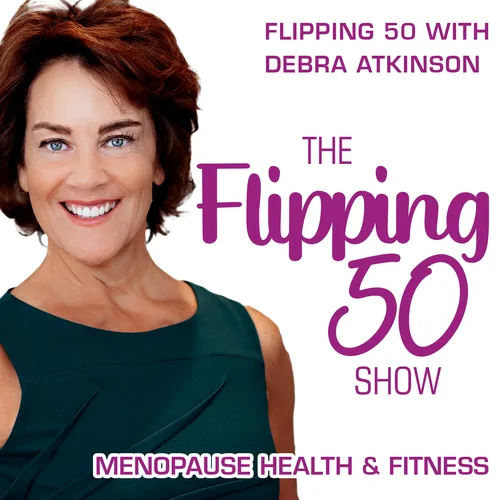What Is Sarcopenia and How to Avoid Sarcopenia In Menopause
- Author
- Debra Atkinson
- Published
- Fri 01 Aug 2025
- Episode Link
- http://sites.libsyn.com/56070/what-is-sarcopenia-and-how-to-avoid-sarcopenia-in-menopause
What is sarcopenia and why is this such an important topic for every woman over 40?
That is the topic of conversation today.
What is Sarcopoenia?
- Sarcopenia is to muscle what osteoporosis is to bone.
- Significant loss of skeletal muscle mass and or muscle strength.
- Sarcopenia is tied to anabolic resistance in midlife women, making it harder to gain lean muscle growth or maintenance after 40. Older adults - both men and women - have to work harder to gain lean muscle mass.
- Women have less overall body mass and muscle to begin with and more dramatic reductions in estrogen at menopause, than men experience loss of testosterone.
- The key stimulus for muscle protein synthesis, will suffer more from loss of strength and mass if they aren’t carefully offsetting it with planned and progressive resistance training.
- For women, estrogen protects muscle and bone. We need and use testosterone which is the most abundant hormone in the female body - but it’s the decline in estrogen that makes the difference in muscle preservation.
What Contributes to Sarcopenia?
- Malnutrition.
- Combined with sarcopenia, it’s a predictor of all-cause mortality than sarcopenia alone.
- The United States is one of the most overfed and undernourished countries in the world. We’re not eating well enough to sustain health.
Sarcopenia is 100% avoidable.
How Do You Measure Sarcopenia?
- Strength
- Fat free mass and height
- Online calculators
- There are physical tests or measures that include grip strength or calf circumference.
- Women didn’t measure or track their skeletal muscle mass decades ago to know where it was at peak. It's harder to say how much mass or strength you’ve lost.
The Surprising Statistics on What is Sarcopenia
- On average, muscle loss occurs 3-8% each decade starting at 30. That CAN accelerate during menopause transition.
- It isn’t associated with loss of estrogen driving skeletal muscle protein synthesis down. It’s the side effects of the decline of estrogen.
- Not sleeping.
- Struggle exercising as hard or as long
- Less support for your muscle from testosterone and growth hormone
- Have cortisol, ghrelin and leptin hormone dysregulation that interferes with muscle and fat.
We do have the ability to regain lean muscle.
It’s proven (and shared in prior episodes) that 85+ individuals can gain both mass and strength.
Available Sarcopenia Assessments:
-
SARC-F
- A simple questionnaire that is a good point of reference but an easy assessment if you’re active.
- How it works:
- Includes 5 components with scale scores range from 0 to 10:
- Strength: How much difficulty do you have in lifting and carrying 10 pounds?
- Assistance in walking: How much difficulty do you have walking across a room, whether you use aids or need help to do this?
- Rise from a chair: How much difficulty do you have transferring from a chair or bed, whether you use aids or need help to do this?
- Climb stairs: How much difficulty do you have climbing a flight of 10 stairs?
- Falls: How many times have you fallen in the past year?
-
- Helps not only measure strength and muscle mass but to see how you rank according to others in your age group.
- Most important is progress, comparing you to you. Start where you are by benchmarking it and learn how to improve it.
How is Sarcopenia Diagnosed?
- Fat-Free Mass Index: FFMI ≤ 15 kg/m2 Visit this URL to calculate (turn on metric to see result): https://ffmicalculator.org/
- A strength test.
What is Sarcopenia: The New Glossary
- Osteosarcopenia - low bone mass and low muscle mass
- Sarcobesity - low muscle mass and high fat mass
- Osteosarcobesity - low bone mass, low muscle mass and high fat mass
- Osteobesity - low bone mass and high fat mass
The biggest risk of sarcopenia is falling due to instability and inability to “right” yourself when slips and falls occur.
I promised we’d visit what’s possible so here that is: A 1.9-3.3% increase in global muscle mass in humans is associated with a 4.1% to 5.8% lower fat mass and reduced A1c and fasting glucose in studies lasting 2 weeks to 3 years.
How to Avoid Sarcopenia?
- Resistance train 2x per week minimum, for some that’s maximum. Know your recovery needs.
- Consume high protein foods and micronutrient dense foods at each meal.
Wouldn’t it be wonderful if in 30 or 40 years, “What is sarcopenia?” is a question like “What is scurvy or rickets?” now which is never heard of.
That starts with us.
References:
- Nutrients. 2023, PMID: 38201856.
- Sports Medicine, 2025, PMID: 40576707.
- Advances in Nutrition 2025, PMID: 40222723.
- Scientific Reports, 2025, PMID: 39833326.
- Front Med (Lausanne), 2025, PMID: 40636391.
Other Episodes You Might Like:
- Previous Episode - Stronger Muscles, Longer Life: The Untold Value of this Accessible to All Anatomy
- Next Episode - How Mold Toxicity Affects Hormonal Balance During Menopause And Effective Detox Strategies
- More Like This:
Resources:
- Don’t know where to start? Book your Discovery Call with Debra.
- Use Flipping 50 Scorecard & Guide to measure what matters with easy at-home self-assessment test you can do in minutes.
- Opening in August!! Join the Hot, Not Bothered! Challenge to learn why timing matters and why what works for others is not working for you.
